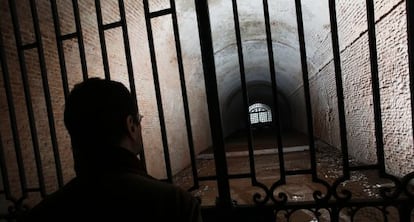Bonaparte’s tunnel battles to see the light
Escape route from Royal Palace remains shut off following M-30 and Madrid Río building work

If Joseph Bonaparte, the so-called “intruder king” who sat uncomfortably on the Spanish throne between 1808 and 1813, wanted to use the tunnel he commissioned between Madrid’s Royal Palace and the nearby Casa de Campo today, he would find his way blocked by the walls of the subterranean M-30 beltway, constructed two centuries later.
Built in 1809 by royal architect Juan de Villanueva, the tunnel is 45 meters long and ran between the Campo del Moro palace gardens and the Casa de Campo, a former royal hunting estate. Although it remains intact, it now lies four meters beneath the Madrid Río riverside park. It terminates in a huge seven-meter-high, 300-square-meter concrete space that also houses one of the M-30 emergency exits. Climbing the steps, one emerges into the well-tended gardens of Madrid Río. On the external wall is a plan by Carlos Ibáñez e Ibáñez de Íbero dating from 1874 showing the original designs for Bonaparte’s tunnel.
Although the tunnel cannot be accessed from either the Campo del Moro or Madrid Río today, Ginés Garrido, the lead architect on the Madrid Río project, recalls the hours he spent trying to find a solution to prevent it from disappearing. “We built the huge space where the exit to the tunnel was, thinking that in the future it could be used as a multifunctional room,” she says while descending the steps that lead into it.
When the architectural team took on the challenge of Madrid Río in 2005, they found they had a “totally incomprehensible” wasteland on their hands. “At first we couldn’t make head nor tail of it; there were grilles and other elements that we couldn’t work out why they had ended up where they had,” says Garrido. From there, they had to work out how to mold the land around the river, and it was impossible for the exit to Bonaparte’s tunnel to remain on the outside.
Above are two lanes of the M-30, and 10 meters below is Line 6 of the Madrid Metro
That fact does not sit well with the platform Salvamos la Casa, which wants to preserve the gardens and their heritage. “The construction of the M-30 completely removed the link between the Casa de Campo and the Campo del Moro gardens and decontextualized Bonaparte’s tunnel,” says Luis de Vicente, a member of the platform, which sent various letters to government departments. “A perfect opportunity to place value on Villanueva’s tunnel has been lost.”
The administration responded in 2006 that it would carry out work to restore the original brickwork, which was covered in the 19thcentury. The Culture Ministry’s national heritage department also replied in kind. “In no moment,” it assured De Vicente, had it considered that the tunnel would disappear. In fact it had a plan to lengthen it from the Campo del Moro to the Puerta del Rey in the Casa de Campo.
Bonaparte’s tunnel is not listed as a protected Object of Cultural Interest, but because it emerges from the Campo del Moro it enjoys the same Historical Landscape status bestowed on the gardens. Years ago a project to restore the tunnel and open it to the public after part of it was swallowed up by the M-30 building work was mooted, but never came to pass.
Garrido believes that the department responsible for the M-30 “did what it could.” She notes that the position of the tunnel is extremely tricky. Above are two lanes of the M-30, and 10 meters below is Line 6 of the Madrid Metro. If the section were cut in two, it would resemble a a piece of Gruyére cheese.
Tu suscripción se está usando en otro dispositivo
¿Quieres añadir otro usuario a tu suscripción?
Si continúas leyendo en este dispositivo, no se podrá leer en el otro.
FlechaTu suscripción se está usando en otro dispositivo y solo puedes acceder a EL PAÍS desde un dispositivo a la vez.
Si quieres compartir tu cuenta, cambia tu suscripción a la modalidad Premium, así podrás añadir otro usuario. Cada uno accederá con su propia cuenta de email, lo que os permitirá personalizar vuestra experiencia en EL PAÍS.
¿Tienes una suscripción de empresa? Accede aquí para contratar más cuentas.
En el caso de no saber quién está usando tu cuenta, te recomendamos cambiar tu contraseña aquí.
Si decides continuar compartiendo tu cuenta, este mensaje se mostrará en tu dispositivo y en el de la otra persona que está usando tu cuenta de forma indefinida, afectando a tu experiencia de lectura. Puedes consultar aquí los términos y condiciones de la suscripción digital.
Últimas noticias
The complicated life of Francesca Albanese: A rising figure in Italy but barred from every bank by Trump’s sanctions
Half of Scotland is in the hands of 420 property owners
Pinochet’s victims grapple with José Antonio Kast’s rise in Chile
Reinhard Genzel, Nobel laureate in physics: ‘One-minute videos will never give you the truth’
Most viewed
- Pablo Escobar’s hippos: A serious environmental problem, 40 years on
- Why we lost the habit of sleeping in two segments and how that changed our sense of time
- Charles Dubouloz, mountaineering star, retires at 36 with a farewell tour inspired by Walter Bonatti
- Reinhard Genzel, Nobel laureate in physics: ‘One-minute videos will never give you the truth’
- The Florida Keys tourist paradise is besieged by immigration agents: ‘We’ve never seen anything like this’









































